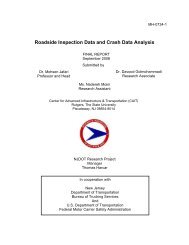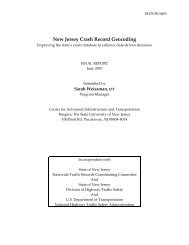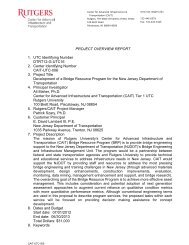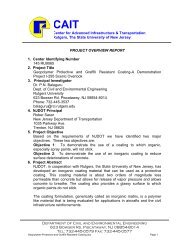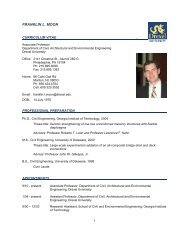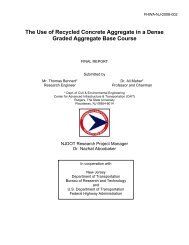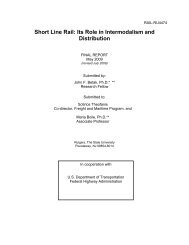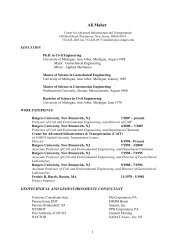Download this report - CAIT - Rutgers, The State University of New ...
Download this report - CAIT - Rutgers, The State University of New ...
Download this report - CAIT - Rutgers, The State University of New ...
You also want an ePaper? Increase the reach of your titles
YUMPU automatically turns print PDFs into web optimized ePapers that Google loves.
Chapter 2: <strong>The</strong> dTIMS CT Database<br />
following diagram illustrates how a section perspective relates to locations along the road elements<br />
and how to conceptualize the data in the perspective table.<br />
Perspectives • Repeating Point Type<br />
Defines a set <strong>of</strong> point elements where more than one element can exist at any particular location. This<br />
perspective allows agencies to store things such as accidents or signs. <strong>The</strong> following diagram<br />
illustrates how a repeating point perspective relates to locations along the road, elements and how to<br />
conceptualize the data in the perspective table.<br />
Perspectives • One to Many Type<br />
Defines a set <strong>of</strong> elements such as maintenance activities, where one element in a source perspective<br />
relates to many elements in <strong>this</strong> perspective. <strong>The</strong> following diagram illustrates how a section<br />
perspective relates to locations along the road, elements and how to conceptualize the data in the<br />
perspective table.<br />
In a one-to-many relationship, the connecting text only attribute must contain only unique values. A<br />
record in Perspective A can have many matching records in Perspective B, but a record in Perspective<br />
B has only one matching record in Perspective A.<br />
An Example: one vendor could supply more than one product, but each product has only one vendor.<br />
This type <strong>of</strong> perspective is not available to Stripmaps.<br />
Perspectives • Many to One Type<br />
A many-to-one relationship is where one entity (typically a column or set <strong>of</strong> columns) contains values<br />
that refer to another entity (a column or set <strong>of</strong> columns) that has unique values.<br />
In relational databases, these many-to-one relationships are <strong>of</strong>ten enforced by foreign key/primary key<br />
relationships, and the relationships typically are between fact and dimension tables and between levels<br />
in a hierarchy.<br />
Foreign key is the link between two tables. Given a value from a row in one table you can access<br />
another table to find the row with related data.<br />
NJDOT Deighton dTIMS CT User Manual 23



